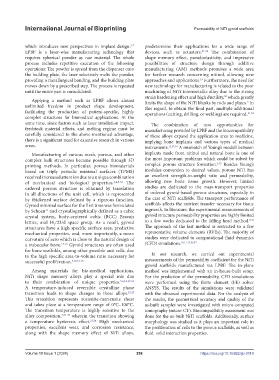Page 266 - IJB-10-1
P. 266
International Journal of Bioprinting Permeability of NiTi gyroid scaffolds
which introduces new perspectives in implant design. predetermine their applications for a wide range of
2-7
LPBF is a layer-wise manufacturing technology that devices, such as actuators. 27-29 The combination of
requires spherical powder as raw material. The whole shape memory effect, pseudoelasticity, and impressive
process includes repetitive execution of the following possibilities of structure design through additive
operations: The powder is spread from the dispenser onto manufacturing (AM) methods promises a wide area
the building plate, the laser selectively melts the powder, for further research concerning nitinol, allowing new
providing a metallurgical bonding, and the building plate approaches and applications. Furthermore, the need for
19
moves down by a prescribed step. The process is repeated new technology for manufacturing is related to the poor
until the entire part is consolidated. machining of NiTi intermetallic alloy due to the strong
strain hardening effect and high ductility, which greatly
30
Applying a method such as LPBF allows almost limits the shape of the NiTi blanks by rods and plates. In
5
unlimited freedom in product shape development, this regard, to obtain the final part, multiple additional
facilitating the production of patient-specific, highly operations (cutting, drilling, or welding) are required. 31,32
complex structures for biomedical applications. At the
same time, since factors such as laser irradiation impact, The combination of new opportunities for
feedstock material effects, and melting regime must be manufacturing provided by LPBF and the biocompatibility
carefully considered to the above-mentioned advantage, of these alloys expand the application area to medicine,
there is a significant need for extensive research in various implying bone implants and various types of medical
areas. instruments. 12,33,34 A mismatch of Young’s moduli between
Manufacturing of various mesh, porous, and other implants made from nitinol and natural bone is one of
complex bulk structures became possible through 3D the most important problems which could be solved by
6,12
printing methods. In particular, porous biomaterials complex porous structure formation. Besides Young’s
based on triply periodic minimal surfaces (TPMS) modulus conversion to desired values, porous NiTi has
received increased attention due to a unique combination an excellent strength-to-weight ratio and permeability,
of mechanical and biological properties. 2,4,8-12 The allowing new bone tissue growth. However, limited
ordered porous structure is obtained by translation studies are dedicated to the mass-transport properties
in all directions of the unit cell, which is represented of ordered gyroid-based porous structures, especially in
by thickened surface defined by a rigorous function. the case of NiTi scaffolds. The transport performance of
Gyroid minimal surface for the first time was formulated scaffolds affects the nutrient transfer necessary for tissue
by Schoen and crystallographically defined as a cubic ingrowth. In literature, the experimental measurements of
13
crystal system, body-centered cubic (BCC) Bravais gyroid structure permeability properties are highly limited
9,35
lattice, and I4 /23/d space group. As a result, gyroid to a few works dedicated to the falling head method.
1
structures have a high specific surface area, predictive The approach of the last method is restricted to a few
mechanical properties, and, more importantly, a mean representative volume elements (RVEs). The majority of
curvature of zero which is close to the natural design of studies were dedicated to computational fluid dynamics
a trabecular bone. 14-16 Gyroid structures are often used (CFD) simulations. 10,11,17,36,37
for bone scaffolds, among other possible unit cells, due
to the high specific area-to-volume ratio necessary for In our research, we carried out experimental
successful proliferation. 7,12,17,18 measurements of the permeability coefficient for the NiTi
gyroid scaffolds manufactured via LPBF. The in-plane
Among materials for bio-medical applications, method was implemented with an in-house-built setup.
NiTi shape memory alloys play a special role due For the prediction of the permeability, CFD simulations
to their combination of unique properties. 5,6,12,19-21 were performed using the finite element (FE) solver
A temperature-induced reversible crystalline phase ANSYS. The results of the simulations were validated
transition leads to shape changes in these alloys. 22,23 with the obtained experimental data. For the analysis of
This transition represents austenite-martensite shear the results, the geometrical accuracy and quality of the
and takes place at a temperature range of 0°C–100°C. as-built samples were investigated with micro-computed
The transition temperature is highly sensitive to the tomography (micro-CT). Biocompatibility assessment was
alloy composition, 5,24-26 wherein the transition showing done for the as-built NiTi scaffolds. Additionally, surface
a temperature hysteresis effect. 23,24 High mechanical morphology was studied as it plays an important role in
properties, excellent wear, and corrosion resistance, the proliferation of cells to the porous scaffolds, as well as
along with the shape memory effect of NiTi alloys, fluid–solid interaction properties.
Volume 10 Issue 1 (2024) 258 https://doi.org/10.36922/ijb.0119

